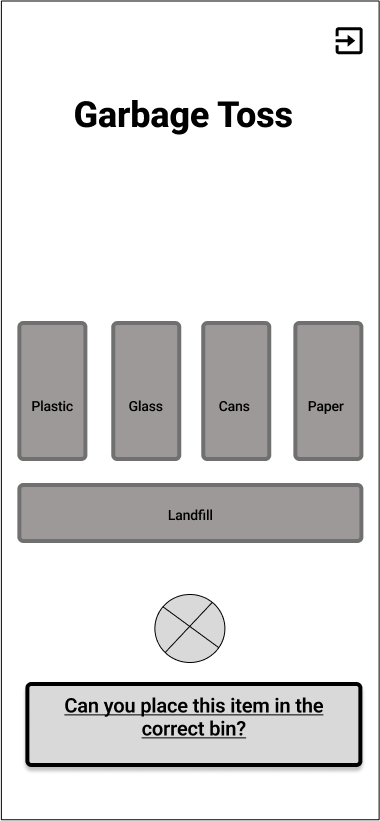
Sort Stop
Mobile app concept making learning about recycling fun, quick, and easy.
Background
Let's dive into the recycling world! It's supposed to be easy, right? But why does it feel like solving a Rubik's Cube? I've tried reading, watching, and chatting up a storm, but the more I learn, the fuzzier it gets! Time to unravel the mystery of recycling. Who's with me?
What is Sort Stop?
Sort Stop is a user-friendly app that gamifies recycling education with daily facts and interactive games. It also helps users find local recycling sites for easy access.
“Yes, recycling is broken. It’s still worth doing”
Problem
Recycling-conscious citizens are confused about what can and cannot be recycled, and they find recycling inconvenient. They care about the environment and are willing to make sustainable choices, but need to feel confident and motivated.
Solution
The app focuses on convenience, ease, and fun to help users to learn about recycling and find sites to encourage participation.
The Design Process
Research
In my research approach, I utilized a known/unknown board to map out my existing knowledge and pinpoint areas for further investigation regarding consumer behavior and recycling.
To refine my research problem statement, I conducted secondary research, sourcing statistical data from organizations like the Recycling Partnership and the EPA. Simultaneously, I conducted competitive analysis to explore existing apps in the recycling domain.
Recognizing the necessity for direct user insights, I conducted user interviews via Zoom. From the insights gathered, I created an affinity map to synthesize key themes. These insights informed the development of a persona, embodying the needs and preferences of the target audience.


Ideate
After reviewing the research findings and revisiting the problem statement, I engaged in rapid ideation, generating numerous "how might we" statements and potential solutions.
To refine the scope of my design efforts, I translated these statements and solutions into user stories. Subsequently, I conducted a thorough analysis of the user stories, grouping and prioritizing them. This process enabled me to identify and focus on the stories that best aligned with my research insights and problem statement.
From the user stories, I developed user flows that were used to create wireframes. The gap between user flows and gamification wireframes was a great challenge. I conducted more than five rounds of user testing and iterations to refine the designs. Transitioning from wireframes to low-fidelity designs was a time-intensive process, demanding careful attention to detail to ensure cohesion, clear instructional language, and an intuitive user experience. This meticulous approach ultimately led to the development of a functional prototype that embodied cohesive design principles and provided a user-friendly interaction experience.










Prototype
This stage marked an important step in the project. Building on the insights from research and ideation, I began the process of visualizing the app.
Starting with a mood board, I explored different typefaces and color palettes to establish the app's visual identity. While this was time-consuming, it was a valuable learning experience as it was my first venture into visual design within UX.
Given the gamified approach I envisioned, I ensured that the visuals aligned with this concept. This iterative process helped refine the app's focus and improve its visual appeal, marking significant progress in my journey as a novice UX designer. Thus, I completed high fidelity designs.
Finalize
Following numerous iterations, I finalized the high-fidelity design. Subsequently, I conducted moderated user testing interviews to gather valuable feedback.
Next Steps
The app design process unfolded through various twists and turns, shaped by ongoing research endeavors. Despite the limitations of a small sample size, which influenced the exploration of user goals and problem understanding, I see immense potential for future development.
Primarily, I envision expanding current research efforts to delve deeper into the underlying causes of user confusion, thereby informing the enhancement of app features and functionalities.
Reflecting on the app's current state, I am keen to assess whether users are effectively learning from the provided facts or if their focus predominantly lies on the gaming aspect. There's significant scope to explore the gamification of learning further, akin to platforms like Duolingo, which offer ongoing checks, reviews, and visible progress to facilitate reflection on learning outcomes.
Exploring additional features and games to cater to diverse learning styles is also a priority. Additionally, given the app's game-centric approach and its alignment with research findings, I'm particularly interested in evaluating the uptake of the "Find my Bin" feature.
Moving forward, these next steps promise to refine further the app's effectiveness in addressing user needs and fostering a more sustainable approach to recycling education.
Reflection
This project marked my debut in the UX bootcamp world, offering a structured roadmap to follow. It was a blend of learning the ropes and getting hands-on experience with various tools. Regular check-ins with my mentor and reflective assignments were invaluable for stepping back and seeing the bigger picture of problem-solving.
Looking back, I realize the importance of revisiting the problem statement. At the outset, I had my own ideas driving the research, but I learned to challenge my biases and stay neutral. This shift led to embracing gamification and tweaking features based on real user feedback.
I'm particularly proud of the visual progress, especially considering it was my first dive into design. Gamifying the app was a fun challenge that I thoroughly enjoyed.
Moving forward, I've ingrained the importance of prioritizing research and pausing for reflection at each stage of the process. I've learned that rushing through steps without considering previous results can significantly impede progress. Similarly, I've recognized the potential pitfalls of using too many tools, which can sometimes divert focus from the intended direction of future steps.


















